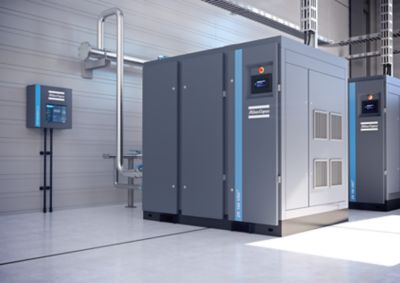Lower natural gas consumption with heat recovery
Wernsing Feinkost needs process heat around-the-clock. The company covers part of the amount needed, 350 kW, by using compression heat from the compressed air station. How? With Atlas Copco ZR oil-free screw compressors with an energy recovery system
Máy nén trục vít Máy nén khí không dầu Giải pháp tái tạo năng lượng Thực phẩm & Đồ uống Rotary drum dryers Class 0
Heat is generated when the air is compressed, and compressors have to be cooled constantly. We wanted to use this heat in our boiler house to preheat soft water for steam generation, because there we can use it as process heat all year long.
A heat power of up to 350 kW
Based on an exact measurement of the compressed air consumption, Atlas Copco proposed a compressed air station with two water-cooled, oil-free model ZR 250 VSD and ZR 160 screw compressors, with a total of 410 kW installed power.
Water cooling and heat recovery go together perfectly as the cooling water, with a temperature of up to 90°C, can very easily transfer the compression energy via a heat exchanger to the heating circuit in the boiler house.
As the two compressors are used nearly to capacity, a heat power of up to 350 kW is available - this corresponds to 80 to 85% of the input electric power. The recovered energy reduces the food company’s natural gas consumption. At the same time it promotes climate protection, as less carbon dioxide enters the atmosphere.
“The cost of heat recovery was not high,” Hartwig Sibbel is happy to report. The new compressors were housed close to the boiler house, meaning one heat exchanger was basically sufficient.
To increase the efficiency of compressed air generation, even more, Wernsing also installed the ES energy-saving control and monitoring system.
High quality dry compressed air
Wernsing chose a product from Atlas Copco for its peripherals. Adsorption dryers from the MD series ensure that a pressure dew point of -20°C is always achieved.
“Some lines run outside and in refrigerated areas,” the Environment and Energy Manager explained. “This makes the pressure dew point even more important, so the water does not condense in the compressed air system and puts the valves and cylinders at risk.” The rotary drum dryers use the hot compressed air to regenerate the desiccant, and therefore do not need any extra energy.
Food safe with oil-free air
For Wernsing, it was also imperative for the compressed air it required to be generated by oil-free compressors only: “We produce food and want to rule out any possibility of contamination with oil.” He can be sure of this, since the ZR compressors from Atlas Copco are all ISO 8573-1, Class 0 certified.

